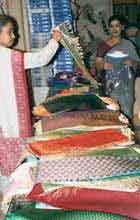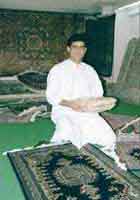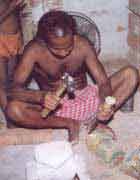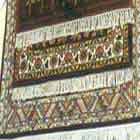Indian crafts have been perfected over the centuries, from traditions and techniques passed on from generation to generation. Each region has its own specialities, each town its own local craftspeople and its own particular skills. India is a country where time honoured tradition co-exists in perfect harmony with the best of modernity. The vast inter-country link of airline services and rail network provides easy access for shopping across the length and breadth of India. Shop to your heart's delight and take home an exquisite piece made in India.
India is the largest brass and copper-making region in the world. From olden days the ivory cravings from Kernel are famous. Indian craftsmen are skilled in making cut, shaped, polished beautiful objects from odd blocks of stone and marble. In the metal craft sector the line dividing crafts and fine arts is practically indistinguishable. The craftsman of India are now better equipped and fully geared to cater to the modern taste and to meet the modern market demands. Painstakingly carved and inlaid, the wooden articles of India are quite a rage with all lovers of woodcarvings. Apart from the statues of the various gods and goddesses, South India is famous for its artistic woodcarvings of wall plaques, statues and toys made of rosewood, sandalwood and teakwood.
India is the home of precious and semi precious stones like mother of pearl, diamonds, emeralds, rubies, sapphires, lapis lazuli, aquamarines, amethysts and others. The process of transforming a rough stone into a shapely object needs great skill in which Indian craftsmen are very adapted. India is at present one of the major centres of diamond polishing industry. Hyderabad is a leading pearl centre. India is also one of the most important countries for the manufacture and export of costume jewellery. It has the largest production base for glass beads. India’s tribal jewellery is a major attraction within the country as well as abroad.
Of all the art forms in the Mughal period, miniature paintings are meticulously painted creations that portray the events and lifestyle of the Mughals in their splendid palaces. The wall paintings of Madhubani are joyous expressions of the women in Madhubani.
One of India's main industries is textile; its silks, cottons, and wools rank amongst the best in the world. Brocade, embroidery, hand block printing are some of the well-known work on textiles. Vivid colours, softness and clear texture characterize the silk weaving of India. The brocade (weaving in gold and silver) has wide variety of techniques and styles. In embroidery the special stitch provides ornamentation to the material. The charm lies in the minuteness of the floral motifs. The heavier work is called zardozi while the embroidery done in metal wire is called zari work. The carpets of India are universally admired for their original patterns, the material (fine wool or silk) and rich colours. India has one of the world's largest carpet industries, and many examples of this ancient and beautiful craft can be seen in museums throughout the world. Each region has its own speciality.
Well-made souvenirs are available from most good hotels, but for the real Indian buying experiences head for any local market. However, before you buy, it is better to compare prices with the neighbouring shop. The Shopping Arcades, branded showrooms of reputed products, national and state government run emporiums are exceptions to this rule. They have high-quality items, but prices are usually a bit higher than elsewhere and you can't bargain. In these places the prices are “fixed”.
Bargaining is the name of the game almost everywhere else. If you don’t bargain - as the Dutch proverb says, “you will be a thief of your own purse”. Shopping is a pleasure especially for those who have the knack for bargaining. Depending on the product, you may want to offer one-third to two-thirds of the initial asking price and take it from there. Remember that haggling for a good price takes time. When buying name-brand items, be careful – it can be a copy. If you see a brand-name product in unexpected places for example a Gucci bag or Channel 5 perfume from a street vendor or a well-known brand candy bar at the corner shop, it is almost certainly not the original.
Most probably the gem dealers would inform you that you could buy gems to take home for profit. It's true. But be careful. You can also get burned - only attempt it if you know a lot about gems.
It is best to avoid any vendors selling animal products like rhino horns, tiger skins, elephant tusks etc. The trade in most of the animal products is illegal.
Ensure that you are fully satisfied with your purchases. Obtain a proper receipt. This may be required by the customs. Return of goods is not entertained. Should the shopping weight be too much to accompany you by air, it can be sent as unaccompanied baggage
Many of the recognised shops will pack the goods and ship the same to your home address. Be sure to get a comprehensive insurance and buy expensive goods like carpets etc. from “established government recognised” shops.
Any item more than 100 years old is classified as an antique. And to take it home you will need an export license. Be sure to obtain prior permission of the archaeological survey of India, which can be arranged from some of the shops.
Most shops that sell to tourists welcome the major credit cards.
See also shopping in India.
Shopping Hours:
Monday-Saturday 9:30 am – 6:00 pm.
In established markets, shopping hours usually stretch on till
night falls.Banking Hours:
Generally Monday - Friday 10:00 –14:00, Saturday 10:00 – 12:00.
Long lines are common, and you are often required to stand in
at least two lines for every transaction.










